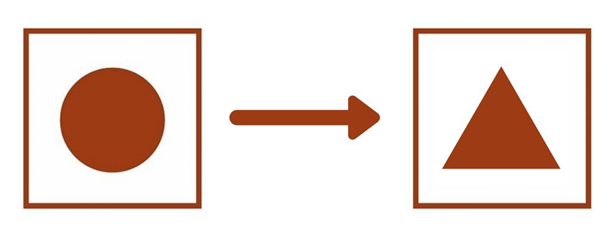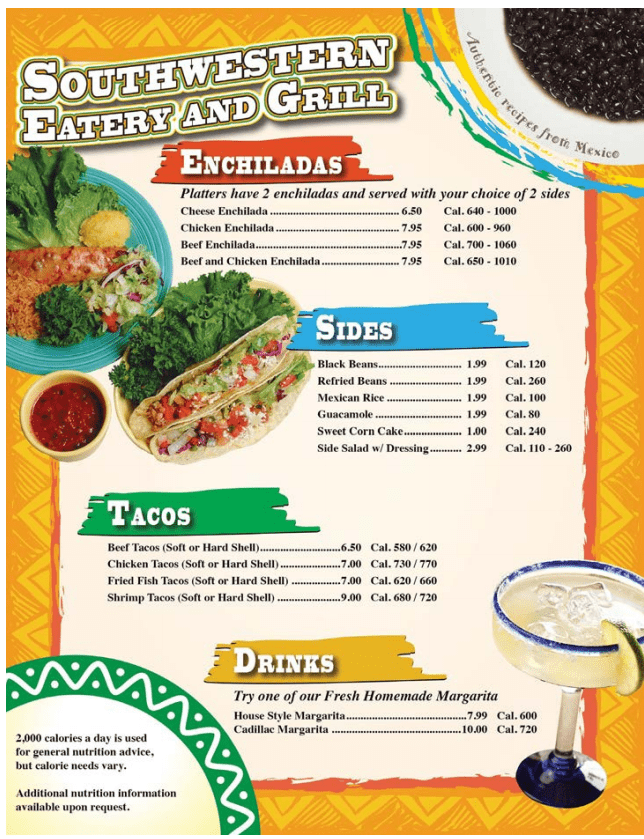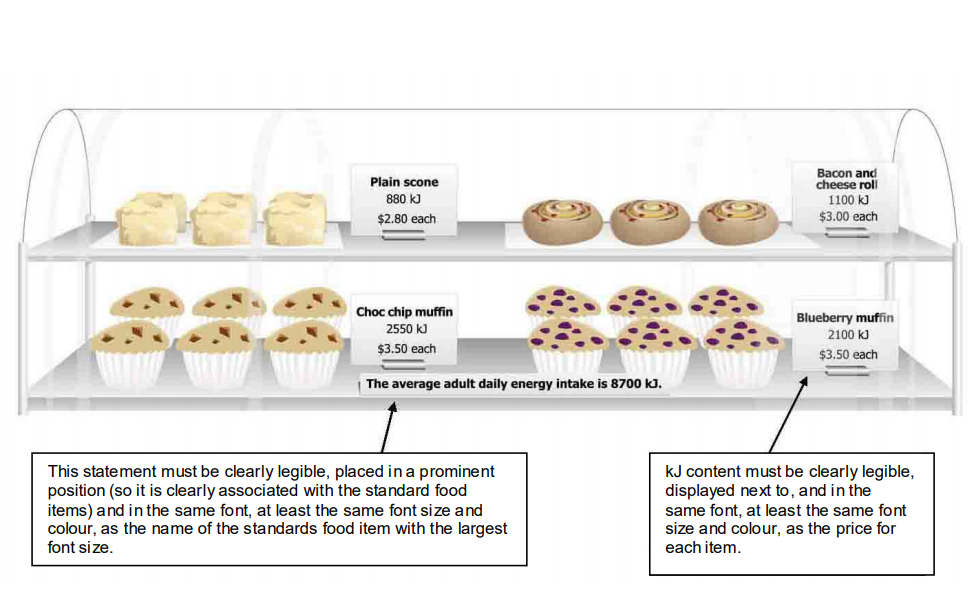What you must know on the Restaurant Menu Labelling Regulations 2020
July 20, 2022

The Food Safety and Standards Authority of India (FSSAI) recently released the Labelling & Display Regulations, 2020. It grabbed a great deal of attention from media, industry, and consumer bodies alike. The new regulations have made the display of the calorie count of food products on menu cards for restaurant chains and online food aggregators mandatory by 1st January 2022.
Food service establishments need to display the Calorific value of food items on menu cards, booklets or boards. E-commerce food business operators will need to get their restaurant partners to display calorie information of food products on their digital platforms.
What are Food Service Establishments?
Food Service Establishments means any of the following:
Hotels, Restaurants, Quick Service Restaurants (QSRs), Bakeries, Coffee Shops, Ice cream Stores, and Takeaways.
Food Delivery and Take-away
E-commerce Food Business Operators
Food Establishments at Places of Entertainment.
FSSAI Regulations for Food Service Establishments
The FSSAI (Labelling & Display) Regulations, 2020 have clearly specified guidelines for Food Service Establishments to display nutrition information on their menus and menu boards. All Food Service Establishments having Central licenses or outlets at 10 or more locations need to display the following information:
Mandatory Information
1. Calorific Information
Calorific information in kcal per serving and serving size should be displayed on the menus. Along with it a disclaimer “An average active adult requires 2,000 kcal energy per day, however, calorie needs may vary” should also be promptly displayed.
2. Food Allergen Information
FSSAI has declared nine allergens to be displayed on food labels. These allergens if present in the recipe should be provided in an easy-to-understand symbols.
3. Vegetarian or Non-Vegetarian Logo

Non Vegetarian Logo

Vegetarian Logo
Conditionally Mandatory Information on Menu Labelling
1. Health Claim Substantiation
Restaurants are required to provide nutrition information of a particular nutrient in case a Health Claim is declared for their menus.
2. Information related to Organic Food or Ingredients
The information relating to organic food or ingredients, if claimed, by the Restaurant for any particular food items sold should be made available to customers upon request in the form of booklets or handouts or on the website.
Who is covered under the Menu Labelling Regulation?
Food Service Establishments having a Central license under FSSAI.
Food Service Establishments having outlets at 10 or more locations.
Ecommerce Food Business Operators. (Should get the nutrition information from respective Food Business Operators and provide it on their website wherever applicable)
Apart from these, the Regulation also encourages Smaller Establishments to Voluntarily declare Nutrition Information.
Food Service Establishments Exempted from the Menu Labelling Regulations
1. Event caterers and Food Service premises that operate for less than 60 days in a calendar year (consecutively or non-consecutively).
These include all Caterers or Food Service Premises that are involved in the preparation, serving, storage and transport of food.
2. Self-serve condiments that are free of charge.
Condiment items which are free to use by the customer of his/her will, such as tomato ketchup, chilli flakes, sauces, etc.
3. Special-order items or modified meals and menu items as per customer’s request.
All those Meal Items are not listed on the Menu, however, prepared as per request by the customer.
Also Read - How will Menu Labelling Impact Restaurants and Consumers?
International Laws on Nutrition Labelling for Food Service Establishments
With a realization of a need for policy change to tackle lifestyle diseases like obesity, many countries have introduced menu calorie labelling. These mandatory and voluntary laws are meant for restaurants, food service establishments and others in similar businesses. As the number of people eating out and ordering food from restaurants has increased, the need for such policies was inevitable. India has been in full agreement with this idea, which is evident in its recent Labelling and Display guidelines of 2020. International laws on menu calorie labelling for food service establishments have gained momentum with most countries robustly setting out guidelines for the same.
Some of the International laws on nutrition labelling for restaurants are detailed here
U.S FDA (Food and Drug Administration)
Internationally, the US FDA has been on the forefront with mandatory declarations for restaurants. As early as 2014, the Final Rule for nutrition labelling in chain restaurants and similar retail food establishments was declared. According to this Rule the following are the establishments covered.
Restaurants both quick service and sit-downs
Grocery, convenience stores, Superstores
Food takeaways and delivery services
Entertainment venues
Cafeterias and coffee shops
Other Food service Operations
These Food Service Establishments are required to mandatorily follow menu calorie labelling, indicating the calorific information on menus and menu boards. At the bottom, a statement “2,000 calories a day is used for general nutrition advice, but calorie needs vary” should appear. Apart from this, other nutrition information such as calories from fat, total fat, saturated fat, trans fat, cholesterol, sodium, total carbohydrates, fiber, sugars, and protein should be made available on request. A statement suggesting the same should also appear at the bottom.

Source: Declaring Calories| Menu Labeling Rule- Key Facts for Industry | FDAMenu Labeling Rule - Key Facts for Industry n Declaring Calories (fda.gov)
The FDA has also given specific guidelines for calorie labelling of items sold under Vending Machines. The calorie information should be placed as a sticker/ placard/ poster on the item, in addition with display of contact information of the operators on the machine.
2. Australian Law
The Council of Australian Governments and the Forum on Food Regulation (formerly known as the Australia and New Zealand Food Regulation Ministerial Council) in 2011, released the Labelling Logic report, which recommended mandatory display of the calorie content of standardised food items on menus in chain food service outlets and vending machines. New South Wales (NSW), South Australia (SA) and the Australian Capital Territory (ACT) have similarly introduced legislation consistent with the National Principles. According to these legislations, food service establishments should mandatorily display the average kJ content of each food item. In addition to this the statement ‘The average adult daily energy intake is 8700 kJ’ should also be declared.
Example: Tea bun 8610 kJ (suggest 7 serves/1230 kJ per serve) or Pizza 7050kJ/882kJ per slice.

Source: Fast Choices: kilojoule menu labelling scheme | Queensland Health | Fast Choices menu labelling – User guide (health.qld.gov.au)
3. European Food Safety Authority
EFSA (European Food Safety Authority) has not yet mandated the menu calorie labelling for restaurants. However, it has included voluntary menu calorie labelling in its Public Health Responsibility Deal in 2011. According to this pledge, nutrition information of Energy content (kJ/kcal) should be provided on menus and menu boards by food service establishments. This pledge states a voluntary commitment to nutrition labelling that empowers consumers to make healthier choices. Many UK restaurants have implemented the nutrition labelling scheme, visible on their websites and establishments.
Also Read - History of Food Labelling
How will Menu Labelling Impact Restaurants and Consumers?
There is a huge wave of discussion on menu calorie labelling and its impact both on the consumers and the Food service establishments. Let’s look at them:
1. Impact of Menu Labelling on Consumer Behaviour
Right to Information:
While most customers believe that restaurants must indicate nutrition values on menu items, consumers rarely seek information from the restaurants or cafés. With this regulation in place, consumers will have access to the calorie content of their favourite dishes across their favourite outlets.
Empowerment to make healthy choices:
Nutrition Information on the menu card will enable the consumer to make conscious, healthier choices. Rational decision making around foods will positively impact the health status of consumers in the country.
Building Trust in food brands:
Reading the list of ingredients, nutritional information, allergen list, and other information about menu items instils a sense of trust in the mind of the consumer toward the brand. Consumers often appreciate the efforts that restaurants put into sharing the correct information in an ethical, transparent manner.
The democratisation of the principles of nutrition:
Reading nutrition information on food items will encourage a greater understanding of food and its impact on consumer health and extend the dialogue to dining tables across households. Additionally, the move will instil mindful consumption as an early habit in children’s lives.
2. Impact of Menu Labelling on Food Establishments
Leadership advantage:
While FSSAI has provided more than a year to restaurants and food service establishments to declare nutrition information, the best thing that consumer-centric brands must do is to take the lead and share the information voluntarily with consumers. On the back of a pandemic, there is a seismic shift in how consumers perceive food. Consumers are seeking to make healthier choices as a lifestyle progression towards mindful consumption that promotes good immunity and overall health.
New Product development:
This is a great time for restaurants to look at their menus and establish a health section within their existing menus. Consumer demand for healthier menu items is on the rise and the trend is here to stay. While staying true to their core values and brand promise, it is essential for restaurants to innovate and create healthier options in their menu for the discerning consumer. We are seeing options like vegan cheesecake, cauliflower rice, keto burgers, protein shakes, multigrain parathas, and many more such innovations adorn the menu card of leading restaurants. This offers a wonderful opportunity for product innovation that combines the values of taste and nutrition, a subject that has remained at loggerheads for time immemorial.
Customer Loyalty and Trust:
Consumers are delighted to see brands that care for their customers. Transparency on ingredients, cooking methods, nutrition information, and allergen lists, leave the customer delighted. This positive experience will help strengthen brand loyalty.
How to get the Calorie and Nutrition Information for your menu?
If this information has got you excited about how menu labelling can change dining experiences in India for the better and you seek support on FSSAI’s menu labelling regulations, the first step is to complete a nutrition analysis for your menu items. Not in a manner of compliance alone. But in a manner of building consumer trust and transparency on a development that is now centre stage of consumer consideration.
We recommend using FoLSol® - India’s 1st digital food labelling solution. This software is more cost-effective than alternative options, but it is also super simple to use. Plus, our FSSAI-compliant online nutrition analysis software will take care of nutrition information, calorie count, nutrient content claims, and allergen info for you—all formatted according to FSSAI rules.
Get Regulatory Compliant Food Labels in under 5 Minutes!
References
1. The Food Safety and Standards Authority of India (FSSAI). Regulations. Food Safety and Standards (Labelling and Display) Regulations. Retrieved from 2020’https://www.fssai.gov.in/upload/notifications/2020/12/5fd87c6a0f6adGazette_Notification_Labelling_Display_14_12_2020.pdf
2. U.S. Department of Health & Human Services. U.S. Food and Drug Administration (FDA). General Information. Menu Labelling Rule- Key Facts for Industry. Retrieved from Menu Labeling Rule: General Information Fact Sheet (fda.gov).
3. U.S Food and Drug Administration (FDA). Overview of FDA Labeling Requirements for Restaurants, Similar Retail Food Establishments and Vending Machines. Retrieved from Overview of FDA Labeling Requirements for Restaurants, Similar Retail Food Establishments and Vending Machines | FDA.
4. U.S. Department of Health & Human Services. U.S Food and Drug Administration (FDA). Declaring Calories. Menu Labelling Rule- Key Facts for Industry. Retrieved from Menu Labeling Rule - Key Facts for Industry n Declaring Calories (fda.gov).
5. State of Queensland (Queensland Health), October 2017. Fast Choices: kilojoule menu labelling scheme. Retrieved from Fast Choices menu labelling – User guide (health.qld.gov.au).
6. Theis D. (2019). Some countries have introduced mandatory nutritional labelling on menus – here’s why the UK should follow suit. The Conversation. Retrieved from Some countries have introduced mandatory nutritional labelling on menus – here's why the UK should follow suit (theconversation.com)
7. The National Archives. Department of Health. Public Health Responsibility Deal. Retrieved from [ARCHIVED CONTENT] Pledge | Public Health Responsibility Deal (nationalarchives.gov.uk)
8.India has a hot new debate on its plate: Should the likes of Burger King, KFC and McDonald’s menus mention calories?. https://www.thehindubusinessline.com/economy/calorie-count-on-restaurant-menu-cards-to-be-made-mandatory-by-2022-fssai/article32447817.ece
9. Eat Right Initiative: With price, restaurant menu also to show nutritive value of cooked food. https://www.indiatvnews.com/news/india/fssai-eat-right-initiative-with-price-restaurant-menu-cooked-food-nutritive-value-638863
10. Impact of Menu Labeling on Consumer Behavior: A 2008–2012 Update. Research Review, June 2013. https://healthyeatingresearch.org/wp-content/uploads/2013/12/HER-RR-Menu-Labeling-FINAL-6-2013.pdf
11. The Impact of Menu Labeling on Consumer Behavior: What’s the Long-Term Goal? https://menucalc.com/2018/12/01/the-impact-of-menu-labeling-on-consumer-behavior-whats-the-long-term-goal/

Olivia Crasto (MSc in Food Processing & Preservation)
Olivia is a Learner for Life, Eco enthusiast and loves to experience nature and its beauty
